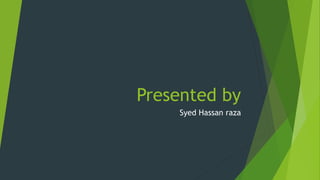
Presented by hassan raza
- 1. Presented by Syed Hassan raza
- 2. Presented to : Rashid Mahmood Khan Topic: Science as a process: Scientific Method
- 3. What is Science? The goal of science is to investigate and understand the natural world, to explain events in the natural world, and to use those explanations to make useful predictions. Science is an organized way of using evidence to learn about the natural world
- 4. What is the Scientific Method The Scientific Method is a process used to find answers to questions about the world around us A method of research in which a problem is identified, relevant data are gathered, a hypothesis is formulated from these data, and the hypothesis is empirically tested.
- 5. Science is a process Science is a process of investigation into the natural world and the knowledge generated through that process. Scientists use multiple research methods to study the natural world. Data collected through scientific research must be analyzed and interpreted to be used as evidence
- 6. CHARACTERISTICS OF SCIENTIFIC METHODS They are orderly & systematic processes Their findings are based on the empirical evidences. Scientific methods are based on assumptions or hypothesis. They are basically conduced to develop or test hypothesis
- 7. PURPOSES OF SCIENTIFIC METHODS The basic purposes of scientific methods are description, exploration, explanation, prediction, control, prescription, & identification of relationship of the facts.
- 8. Which version will we use? We will be using a 7-step version in class with the following steps: 1. Formulate a question. 2. Research the question. 3. Form a hypothesis. 4. Conduct an experiment to test your hypothesis. 5. Analyze data. 6. Draw Conclusions. 7. Communicate results.
- 9. Step 1: Formulate a question What do you want to know or explain? • Use observations you have made to write a question that addresses the problem or topic you want to investigate.
- 10. Step 2: Research the question This is an important step, especially when you do an independent investigation such as a science fair project. • Researching your question lets you know if others have done this same experiment before and if so, what their data suggests. If they had a widely accepted conclusion, you may want to try a different angle with your experiment or test a different variable. You should also research the scientific concepts associated with the experiment. For example, if you are testing to see which paper towel brand is the most absorbent, you should research absorbency, paper material, and quality control testing. This will help answer the “WHY?”
- 11. Step 3: Form a hypothesis What do you think will happen? • A hypothesis is your prediction for the outcome of the experiment. • It is based on your observations and should be testable
- 12. Step 4: Conduct an experiment to test your hypothesis Design a procedure that tests your hypothesis to see if your prediction is correct. • Record all of your data and observations and put them into a table that is neat and organized.
- 13. Step 5: Analyze data Is your data reliable? Does it make sense? • Put your data into a chart or graph and look for any trends.
- 14. Step 6: Draw conclusions • Do your data and observations support your hypothesis? • If you cannot make a definite conclusion, you may need to try the experiment again. • This means you may either need to rewrite your procedure if it was not specific enough; you may need to change your hypothesis.
- 15. Step 7: Communicate results Report the results of your experiment to let others know what you have learned. • This will be represented as either a lab report, oral presentation, or Science Fair display board. • Scientists may want to repeat your procedure to see if they get the same results as you. They may also tweak your experiment a little and have a slightly different focus.
- 16. LIMITATIONS OF SCIENTIFIC METHODS Moral or ethical problem Human complexity Measurement problems